It may be (only?) a coot but I really like the image quality of this eight photo series taken yesterday afternoon.
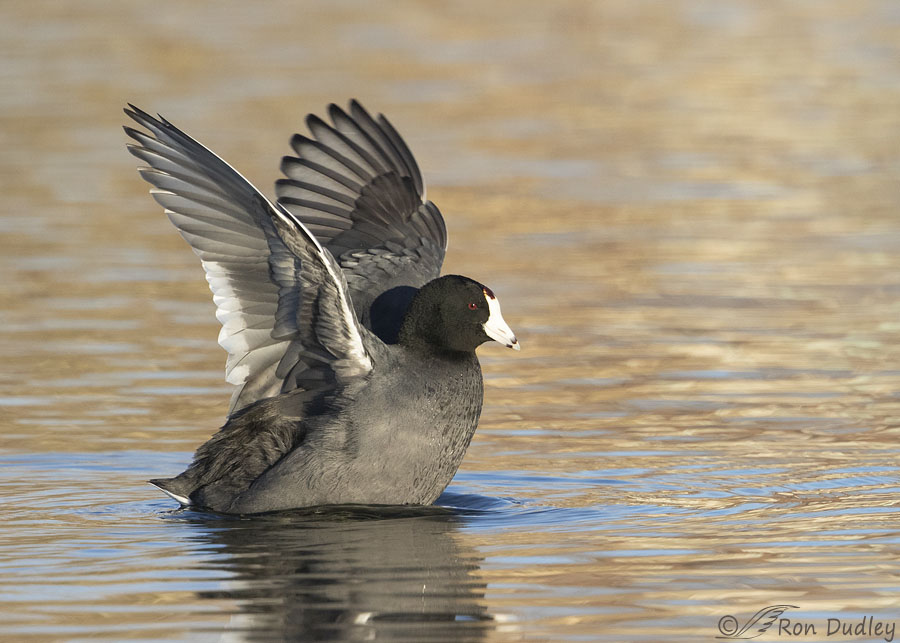
1/2500, f/6.3, ISO 800, Canon 7D Mark II, Canon EF 500mm f/4L IS II USM + EF 1.4 III Extender, not baited, set up or called in
Not long before sunset yesterday I photographed this extended wing-flap of an American Coot at a local pond. This is the first shot I got as the wing-flapping behavior began.
All eight photos are presented in the order they were taken with no skips in the burst except for one – image file #6080 (the photo that would have been between #5 and #6 below as the bird was beginning to settle back down into the water) is missing because I lost sharp focus on the coot.
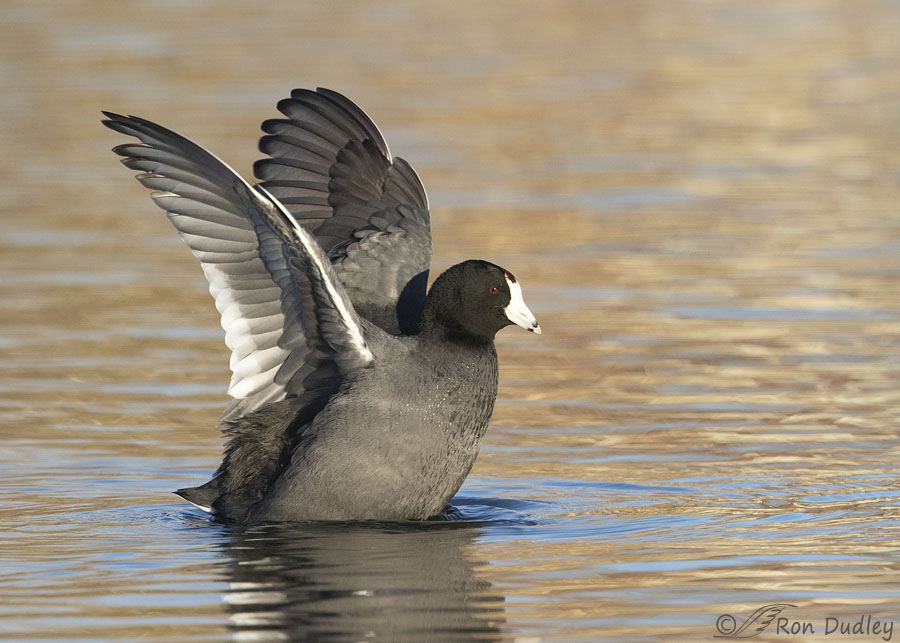
1/2500, f/6.3, ISO 800, Canon 7D Mark II, Canon EF 500mm f/4L IS II USM + EF 1.4 III Extender, not baited, set up or called in
The bird’s wing position in the first five shots in the series will be very similar but there’s a reason I’m including all of them.
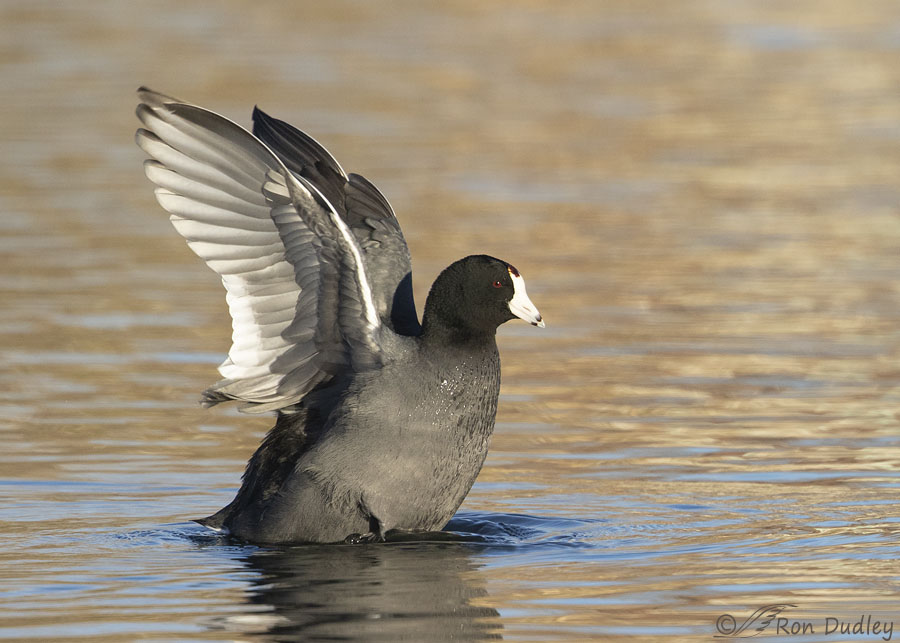
1/2500, f/6.3, ISO 800, Canon 7D Mark II, Canon EF 500mm f/4L IS II USM + EF 1.4 III Extender, not baited, set up or called in
In burst mode my shutter fires at 10 shots per second. The almost exact wing position in the first five shots of this series tells me two things:
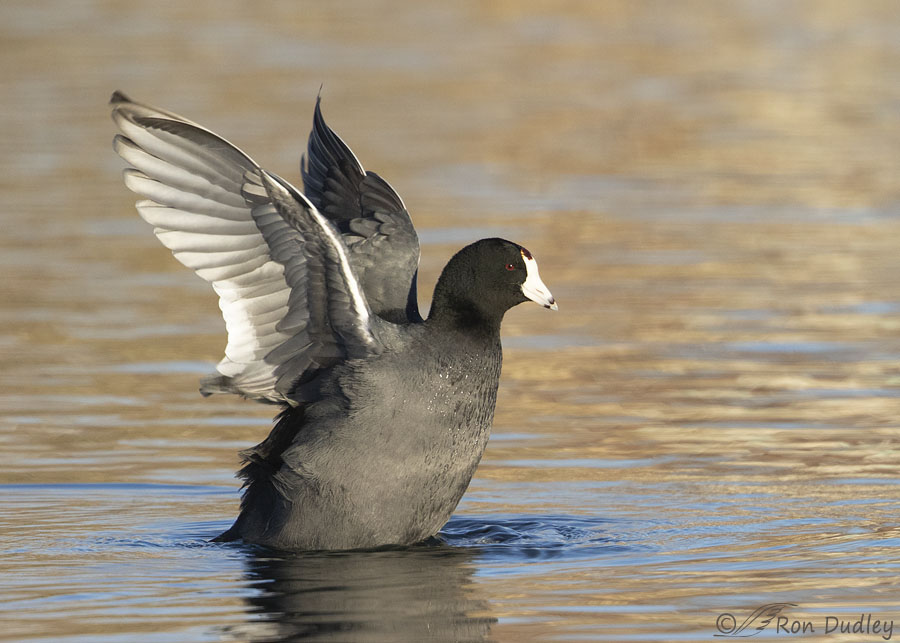
1/2500, f/6.3, ISO 800, Canon 7D Mark II, Canon EF 500mm f/4L IS II USM + EF 1.4 III Extender, not baited, set up or called in
The wing speed of this coot was almost certainly ten flaps per second (male Ruby-throated Hummingbirds can reach 200/sec) and…
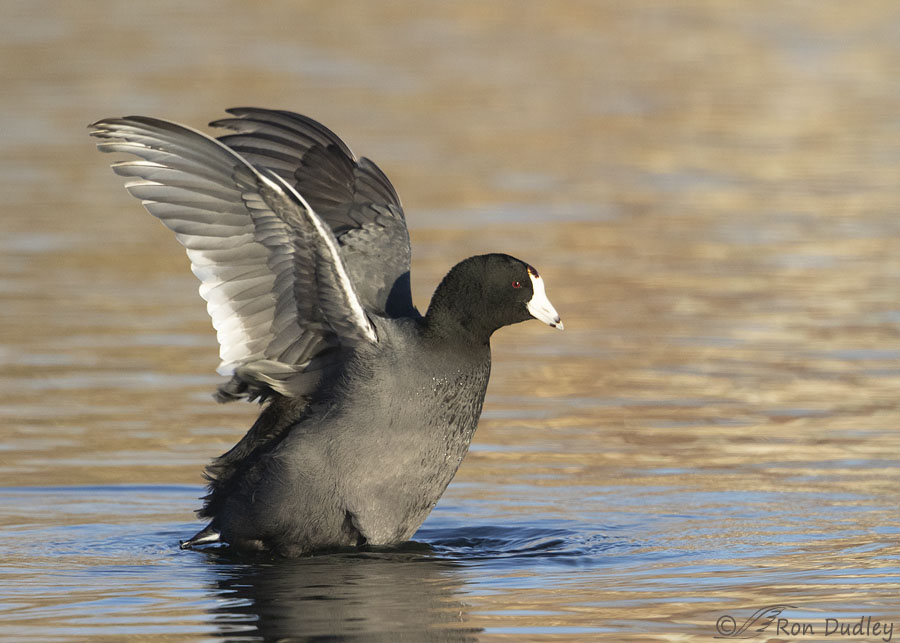
1/2500, f/6.3, ISO 800, Canon 7D Mark II, Canon EF 500mm f/4L IS II USM + EF 1.4 III Extender, not baited, set up or called in
it only took 1/2 of a second for me to take the first 5 shots. That’s pretty darned fast for a bird this size. I like knowing bits of bird minutia like that.
Because my shutter was synchronized with the wing speed I was lucky the timing caught the wings in a visually pleasing vertical position. They could just as easily have been in another position that I like less in all five shots. But to be honest my preference would have been to have avoided the synchronization to give me more variety and potentially a more interesting series overall.
Birds obviously flap their wings faster in place than in flight and when they do so I often wonder what they do or don’t do with their wing angles to prevent them from propelling themselves forward and even possibly becoming airborne. Hmmm, a potential subject for another blog post if I can figure it out and if I have photos to illustrate it well.
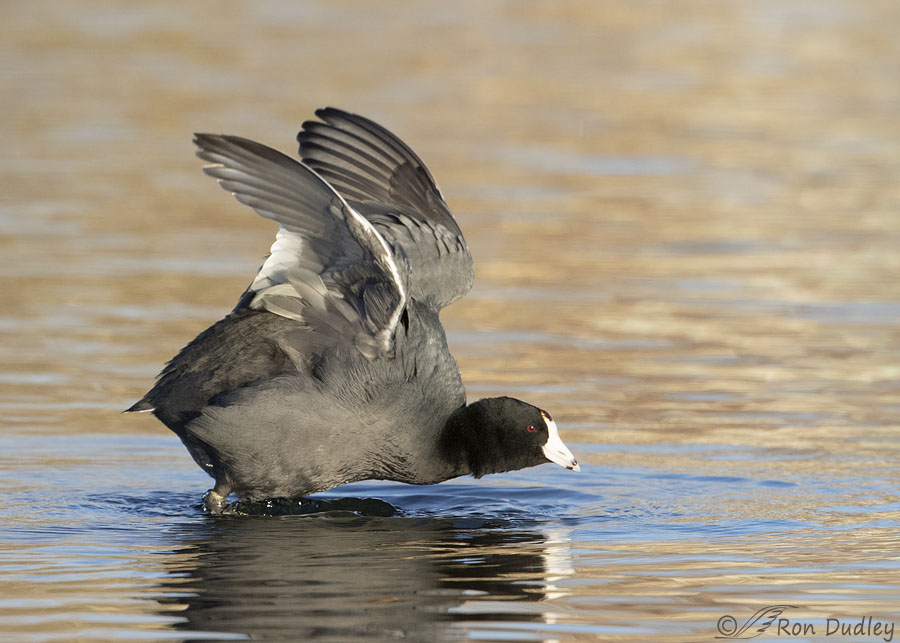
1/2000, f/6.3, ISO 800, Canon 7D Mark II, Canon EF 500mm f/4L IS II USM + EF 1.4 III Extender, not baited, set up or called in
The image before this one is the photo I skipped because it was a little soft. Here the coot is about to settle back into the water after the wing-flapping episode.
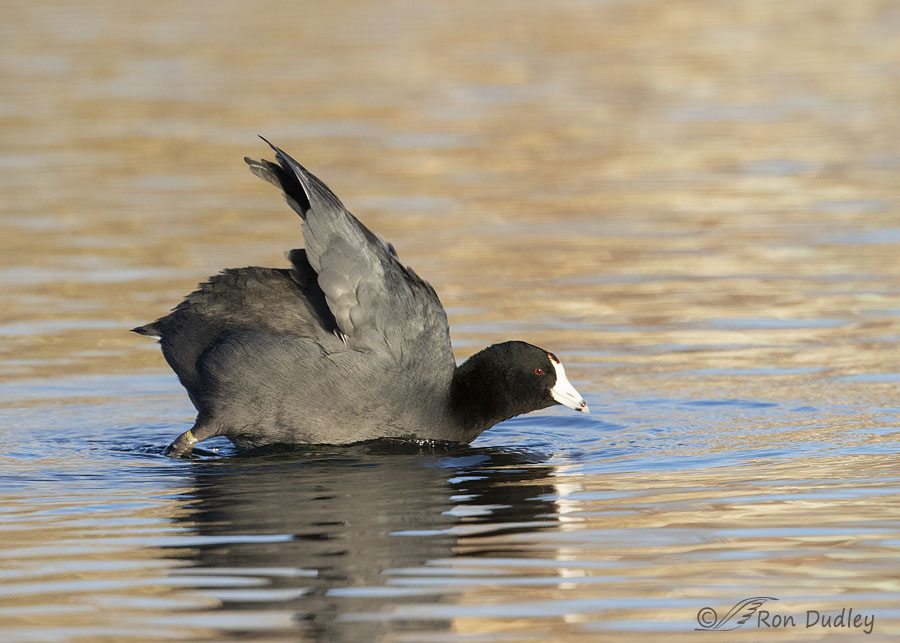
1/2000, f/6.3, ISO 800, Canon 7D Mark II, Canon EF 500mm f/4L IS II USM + EF 1.4 III Extender, not baited, set up or called in
Almost there.
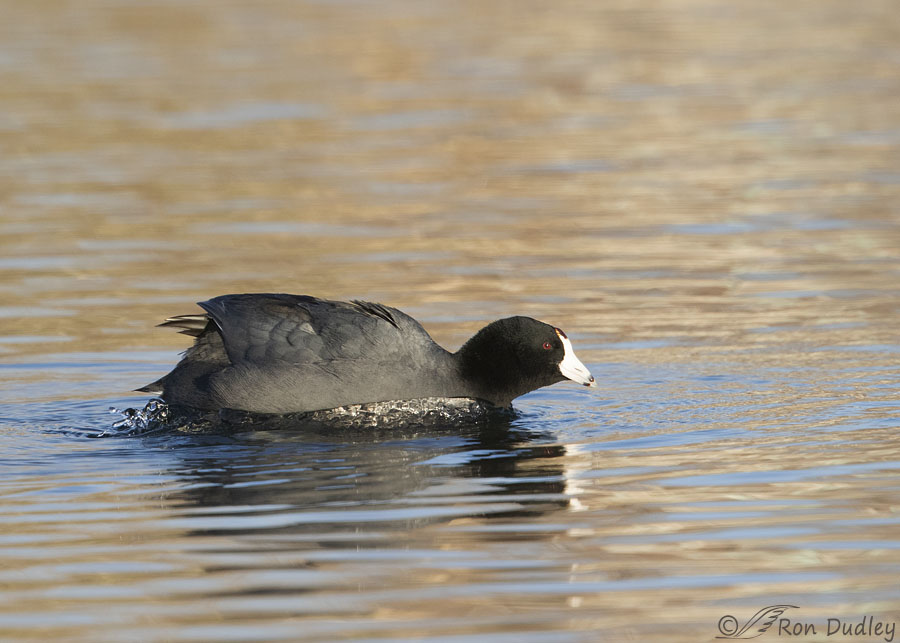
1/1600, f/6.3, ISO 800, Canon 7D Mark II, Canon EF 500mm f/4L IS II USM + EF 1.4 III Extender, not baited, set up or called in
It’s arrived and just about to go about the rest of its business for the late afternoon, including feeding and quarreling with other coots. And that’s yet another reason I like to photograph them – their extremely pugnacious behaviors make them interesting photo subjects, especially during breeding season.
Some bird photographers rarely if ever photograph coots. When asked why the most common answers are either because coots are so common or because they think coots are unattractive. Or both. But I strongly believe there’s a third primary reason. With their ivory-white bills and black and near-black feathers they’re typically quite difficult to expose properly.
For me it doesn’t really matter that they’re common. If it has feathers I’ll photograph it, even European Starlings and House Sparrows on occasion. I don’t think coots are unattractive but even if I did it wouldn’t matter and I’d still photograph them – hell, I photograph Turkey Vultures with relish (now there’s a thought, vultures served with a condiment…). And I see the difficulties of properly exposing them as a challenge or contest that I like to at least try to win.
My primary goal is high quality photographs and the species doesn’t matter much (although I’ll admit that some excite me more than others). What I’m after is sharpness, good light and exposure, appropriate depth of field and shutter speed for the situation, eye catch lights, appealing settings and backgrounds, pleasing compositions and interesting behaviors when I can get them. Whew, that’s a tall order when I think about it.
And I believe most or even all of the coot images in this series hit those marks so I’m quite happy to have them.
Ron
Note: The Club-winged Manakin (Machaeropterus deliciosus) is a bird that uses its wings at very high speeds to produce “song“, similar to what some insects do.


The bird survey group I go out with monthly usually makes a “pit” stop at a particular lake. Often it may not have anything but Coots on it. Typically the group just ignores them. Your post and everyone’s comments brings an appreciation of them I really didn’t have before (and will get the scope out to really see them.)
Lyle, the coots around here are beginning to feel their oats already this year so they’re getting pugnacious and more interesting to watch. It should escalate through late spring. Not many birds fight as viciously and as often as coots.
I kinda love this “old” coot. 😀
Good!
Great series, my favorite is the first shot settling back into the water. I love coots, mostly due to an imprinted coot we had years ago in the rehab, (we did not imprint him he came from a family that had him as a pet). I wanted to name him Napoleon, but Coot Coot stuck. He loved to sit in your lap and have his ears and neck rubbed.
That would have been fun, April.
Aren’t there potential legal consequences for folks who make pets out of native birds?
Yes, but most of the time the animal is confiscated and that is about all that happens. Many people find them as young and think they are helping the animal until the animal is too big and hard to handle, then they often call wildlife officials to take it. Sadly many are euthanized. If a zoo or education opportunity is available all efforts are made to place them.
Ron, I’ve never seen a Coot in person. However, I think that this Coot is kind of cute. It looks like it is at the gym and pinching its shoulder blades for a good stretch. I guess “to each his own”.
The link for the Manakin is quite interesting. Studying and filming this bird must be quite a challenge considering its location.
Thanks Ron and Happy Holiday.
That’s a little surprising that you haven’t seen one, Alice. They’re often fun to watch because they’re so rambunctious and aggressive at times. Other times they can be pretty monotonous to watch for long periods but that’s nothing against them. Thank you and same to you.
Common is as common does. And on that count our species is a great deal more common than this delightful bird. And more pugnacious too. Mostly less graceful though.
Thank you so much for the video clip of the Club-winged Manakin. My mind is boggled. Yet again.
That’s a pretty neat bird, isn’t it, EC! Rivals some of your exotic birds in the land of Oz.
Coots are a challenge as you say and can be bypassed by some not realizing the potential rewards if you can get them “right”. They represent a great opportunity to practice your action photography. You can predict when the aggressive “chasing” behavior is about to begin if you watch carefully, but when the “chase” begins, keeping your subject in the frame, in focus, and without too much motion blur is a tremendous challenge and success is a tremendous reward. And the light better be optimum because, at least for me, excessive noise caused by high ISO’s can result in unacceptable results. And, of coarse, being close represents a Hugh advantage, but conversly, makes the challenge of keeping everything in the frame even more difficult. Perhaps this is why many avoid shooting coots besides the fact that they taste like mud.
Thanks for the post Ron. Have a nice day and happy holidays!
Frank
Yup, I can tell that you’ve been there, done that, Frank. You describe it very well, including watching for the predictive behaviors.
I like to photograph coots mostly because they are so unpredictable. And to catch them when they run over the water is quite a challenge…
“Our” coots are a little different from yours. They don’t have those black marks on the bill nor the red dot on the forehead.
Interesting about the differences in your coots, Jorge. And I agree about the difficulties of catching them running on the water. I fail at that FAR more often than I succeed.
Who gives a Coot? Oh, maybe that is who gives a hoot? 🙂 Or who takes photos of Coots? Ron does, and they are outstanding. The American Coot, the most underappreciated guy or gal in the lake. Yesterday I was taking photos of Northern Shovelers, Northern Pintails, Buffleheads, Canvasbacks, Goldeneyes, Hooded Mergansers, Red-breasted Mergansers, Ring-necked, and Gadwall. Never even thought of including the Coots. Maybe if I could take photos like these I would start including these most often ignored Fulica Americana. Beautiful series Ron.
Everett Sanborn, Prescott AZ
Thanks, Everett. I’m sure you could if you tried. They’re more difficult but that’s part of what makes them fun IMO.
I adore coots. Their behaviors are varied and amusing, and, on the upper Texas coast, their arrival signals winter and their departure means it’s spring. The photos are wonderful. I watched hundreds of them on a pond yesterday, and although my lens wasn’t up to capturing them, it was fun to try while they went about their business.
I think it’s always fun to try, Shoreacres. Others disagree with us, in part because they’re afraid to fail. Not a good way to learn…
I enjoyed your series today & found your explanation taught me something about Coots wing flaps – enjoyed it, Ron. I never knew what a Coot was until watching the Berry College Eagle nest. Gena, one of the photographers who follow the Berry nest had posted a photo of Mom Berry flying over a flock of them, looking for her next meal!! During the Winter months coots were a big part of their diet – Mom Berry especially enjoying their feet (which Coot feet are very interesting). I now see a lot of Coots at Green Cay Wetlands. They and the Common Gallinules are what I see the most of when there. I also agree with you that they are an interesting bird. If you love birds – you love them all!!
In winter around here Bald Eagles prey on coots when they can too, Jo Ann. Or try to steal them from other predatory birds. It’s a good thing for some raptors that coots are as common as they are.
I liked and agree with your last sentence.
‘Oh A Coot’…I’ve heard that phrase so many times, mostly with a disparaging tone. I would feel a bit embarrassed that I photographed them. 🤭 These photographs are very good. I really like the slight variance of the wing in #4 with the twist of the initial feather. #3 shows the slight start of the twist but #4 is beautiful…I’d love to see a head-on photo of that one. Also I find the details of the under feathers here to be lovely…the tonal changes are fantastic. Am I correct in thinking the slightly white dots on the breast feathers are water droplets? I do think your third theory is correct about white and black exposure problems. But it is a nice challenge for us. My favorite Coot photo I have is one with it’s wings held aloft…to me it looked like a tiny black swan ‘wannabe’…I just love it! 😍
Yes, those “white dots” are water droplets, Kathy.
Besides the things you mention I notice how the fast wing action ruffles the body feathers at the base of the wing differently in each shot.
Going back to look I noticed that especially in #3…it gives a beautiful rounded scooped look to the wing. That is a beautiful photo! ❤️ Beautiful details one sees when really looking carefully. Who says…just a Coot?
Not me. Well… to be perfectly honest I have said it before but when I do I always feel guilty about it and at least try to change my ways.
Great Photos as yooosh!
Count me in on “The I love Coots Fan Club”. The first one I saw up here in Massachusetts, when I started looking at birds in earnest, was a thrill to me! Then when I visited Florida I was happy to see lots of them and I am still trying to get a “masterpiece” Coot photo. I love all birds and don’t look down on the invasive ones (starlings are startlingly beautiful) or common ones (all sparrows are subtlely beautiful). Besides, human beings are as common as dirt and the most invasive species on the planet and I do my darnedest not to look down on them. It is difficult though.
“Besides, human beings are as common as dirt and the most invasive species on the planet and I do my darnedest not to look down on them. It is difficult though”
Boy, reams could be written about that statement, Joanne. I feel the same way you do but you put it so well.
LOVE you last sentence, Joanne!! Laughed right out loud!! And to a certain extent, I agree with you. The “bad ones” upset me so that I have to remind my self of the good people!!
Jo Ann Donnelly, your last sentence is so very true of me. Twice this week folks at the pond have been extremely thoughtful and courteous to either avoid walking between us and the birds on the pond (where the sidewalk is) or deliberately walking behind my pickup where it wouldn’t be an issue and that’s so very unusual these days that I thanked each of them profusely.
Most folks are clueless or deliberately rude and they actually often stand right between our lenses and the birds. And some of them do it on purpose – no question about that. Overall I have less respect for our species than I do most others but when I find an exception I REALLY notice.
That’s the truth! 🙂 Hadn’t thought of human’s that way!
And no one has yet mentioned their Amazing Feet! They grow unusual and interesting lobed feet.
What you do IS a tall order…and you obviously work hard at it which makes your images so good…You are also a great teacher which is even better for us..sharing your skills is something many photographers will not do..and I thank you for that…Now about that “only a coot” thing…Never seen a bird I wouldn’t photograph, although some are definitely more fun than others, but they are all beautiful if you look close and without prejudice…These coot shots are great, so thanks again Ron, and I’m glad you shared them….
“they are all beautiful if you look close and without prejudice”
So very true, Steve. I wish I’d used some variation of putting it that way in my post. Thank you for the very kind words.
How interesting and fun! Both that your burst mode speed matched the coot’s wing flaps! If one didn’t “know” you’d think the bird was starting to take off as it settled back into the water. Exposing the high contrast between the beak and bird is a challenge. Coots are also maleigned by duck hunters. Fascinating piece/video on the Club-winged Manakin. 🙂
“Coots are also maleigned by duck hunters”
That’s right, Judy. They often call them “mud-hens” apparently because they taste like mud.
Yeah, I thought that video clip was pretty interesting. Gotta wonder PRECISELY how they do it. Thank you.
Ron, even if they are “Just coots,” I’m definitely in the same boat as you! The only species I ever refuse to photograph are the ecologically dangerous invasive species, like House sparrows, starlings, and mynas (Although the latter has given me doubt on several occasions due to how colorful they are).
Right now my goals this winter are to photograph our winter sparrows before spring when all but 4 species migrate back up north, which many consider sparrows as coot-tier, or worse. Like you said, all that really matters is getting the bird sharp, in good light, with the correct exposure and shutter speed, and in a good body position (You were right about that being a lot to ask for)
Anyways, once again, spectacular photos Ron!
We don’t have Mynas and I don’t photograph House Sparrows or European Starlings very often largely for the reason you mention. But I will if there’s something particularly unusual or interesting about them. Personally I love to shoot native sparrows. Thank you, Xavier.